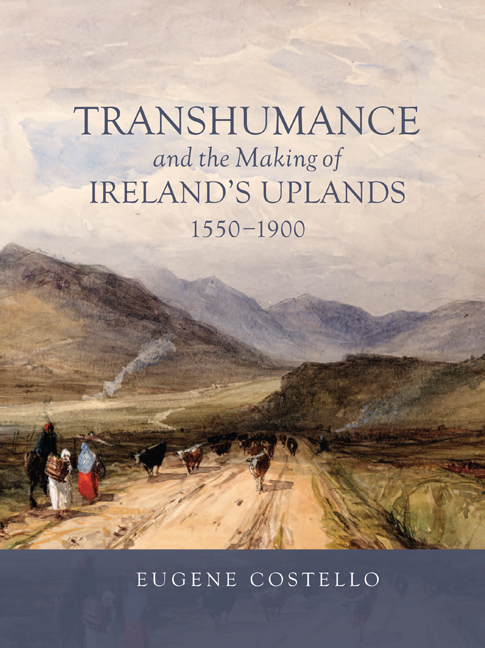Book contents
- Frontmatter
- Contents
- List of Illustrations
- Preface and Acknowledgements
- Note on Chronology
- Introduction
- Chapter 1 Seasonal Movement and Settlement in A World of Pastoralism
- Chapter 2 Imagining Movement: Past and Present Views of Transhumance in Ireland
- Chapter 3 Seasonal Sites in Context: Summer Pastures of the Carna Peninsula
- Chapter 4 Connected Places: Home and Booley in Gleann Cholm Cille Over Time
- Chapter 5 Altitude and Adaptation: Evolving Seasonal Settlement in the Galtee Mountains
- Chapter 6 Herders and Historical Forces, 1600–1900
- Conclusion
- Bibliography
- Index
Chapter 3 - Seasonal Sites in Context: Summer Pastures of the Carna Peninsula
Published online by Cambridge University Press: 01 October 2020
- Frontmatter
- Contents
- List of Illustrations
- Preface and Acknowledgements
- Note on Chronology
- Introduction
- Chapter 1 Seasonal Movement and Settlement in A World of Pastoralism
- Chapter 2 Imagining Movement: Past and Present Views of Transhumance in Ireland
- Chapter 3 Seasonal Sites in Context: Summer Pastures of the Carna Peninsula
- Chapter 4 Connected Places: Home and Booley in Gleann Cholm Cille Over Time
- Chapter 5 Altitude and Adaptation: Evolving Seasonal Settlement in the Galtee Mountains
- Chapter 6 Herders and Historical Forces, 1600–1900
- Conclusion
- Bibliography
- Index
Summary
The first case study centres on the Carna peninsula of south Connemara in County Galway (Figure 3.1). The peninsula forms the majority of the civil parish of Moyrus (Maíros) in the barony of Ballynahinch. Known in Irish – the main language here – as Iorras Aithneach (‘The Stormy Peninsula’), it is located in what is very much a western coastal environment. The peninsula extends approximately 14km out from the mainland in a south-western direction and is 12km across at its widest. The only terrain that exceeds 150m a.s.l. is the ridge of Cnoc Mordáin, running close by its eastern coast (highest point 354m). Hence the vertical element of transhumance in this first study area is not very pronounced, the practice in many instances involving a primarily horizontal movement to rough pastures located on various knolls and low hills in the interior. Human population today is concentrated entirely along the coast and islands, and especially at the peninsula's south-western end, east and west of the small village of Carna. Together with Cill Chiaráin in the south-east, this forms the only services centre for the local population. The interior of the peninsula, although no longer inhabited seasonally by dairy-cow herders, continues to form a minor source of income for some in the community. Farms around the coast still use it as extensive year-round grazing for small numbers of dry Aberdeen Angus and Red Shorthorn cattle, along with some mountain sheep and horses. Machine cutting of peat for household fuel also takes place on a small scale. In addition, some sections of land have been afforested with conifers in the twentieth century, particularly to the south and west of Cnoc Mordáin, though these plantations have not all thrived.
The flatter areas and sinks of the peninsula's interior are occupied by blanket bog and scattered lakes. These tracts of wet bog are unlikely to have been suitable for cattle grazing in the recent past because of the risk of heavier animals getting stuck, though younger cattle – and perhaps sheep too – may have browsed these areas. The highest ridges of Cnoc Mordáin are also unlikely to have been used as rough pasture for cattle because of relatively severe wind exposure and a steep drop along much of Cnoc Mordáin's eastern side.
- Type
- Chapter
- Information
- Publisher: Boydell & BrewerPrint publication year: 2020

